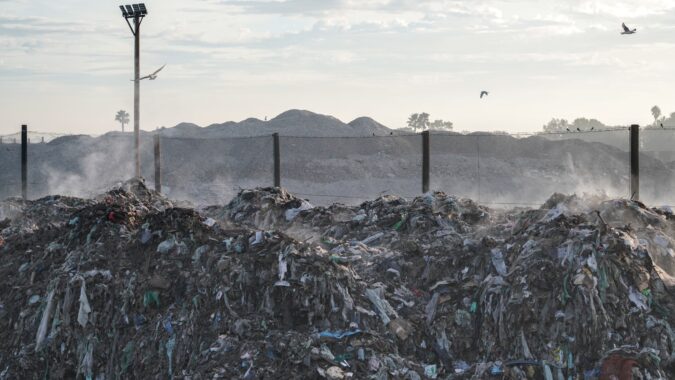A guide to the UK landfill tax
Landfill tax aims to reduce the amount of waste sent to landfill sites by businesses, local authorities, and other organisations. It aims to encourage recycling and increase the uptake of reusable materials. The tax is widely regarded as an effective means of persuading industries to rethink waste management strategies.
Using landfill sites is unsustainable and damages the environment. Recycling is a much greener and cheaper alternative for businesses but not all waste can be recycled. For any rubbish you send to landfill, you’ll face the unavoidable landfill tax. It’s important you understand how much landfill tax you’ll have to pay and when for an effective waste management budget.
Find out everything you need to know about UK landfill tax in this guide.

What is landfill tax?
Landfill tax is an extra environmental tax you must pay when you dispose of any waste at a landfill site. It’s added on top of any normal landfill fees and is charged by weight. The UK government licenses all landfill sites and charges the tax for organisations to use them.
The tax exists to force companies to consider alternative routes for waste, rather than as a way to raise revenue for the central government. It should therefore become a matter of pride for waste management companies to help their customers pay as little as possible through increased recycling.
In most cases, the landfill site operator will pass on the costs of landfill tax by adding it on top of your landfill fees. If you’re a licensed waste carrier and transport waste directly to a landfill site this may be present in your invoice. For most businesses that use professional waste management companies to remove their commercial waste, the tax should be included in your fees.
Who pays landfill tax?
Any business, local authority, or organisation that sends waste to a landfill site must pay landfill tax. Operators of a landfill site with a licence or permit to authorise disposal in or on the land has to pay landfill tax. If the licence holder doesn’t operate the site then normally the controller of the site is liable for landfill tax.
Landfill tax does not apply to households. This is because local councils and authorities are responsible for removing household waste. They’ll pay any landfill tax when transporting general waste to landfill sites and pass on the costs through council tax changes. Many councils try to send more waste for incineration to avoid landfill tax.
According to the Gov.uk website, landfill tax doesn’t apply to dredging activities, quarrying and mining, pet cemeteries, and inactive waste used for filling quarries. Tax credits are also available when sending waste from landfill to be recycled, incinerated, or reused. Filling quarries is one of the preferred routes for avoiding landfill and forms part of the landscaping part of a quarrying project once the site has been exhausted.

How much is
landfill tax?
Landfill tax rates in the UK are normally updated on 1 April each year. There are two landfill tax rates – a standard and a lower rate. The lower rate applies to inert or inactive waste (such as metal, wood, bricks, concrete, and construction materials), while the standard rate is for active waste, but there are exemptions.
Current landfill tax rates and recent landfill tax rates history for the previous two years in England and Wales are:
| Rate from 1 April 2022 | Rate from 1 April 2021 | Rate from 1 April 2020 | |
| Standard rate | £98.60 per tonne | £96.70 per tonne | £94.15 per tonne |
| Lower rate | £3.15 per tonne | £3.10 per tonne | £3.00 per tonne |
When was landfill tax introduced?
Landfill tax was introduced in the UK on 1 October 1996. The conservative Environment Secretary John Gummer brought in the new tax at the time to divert waste from landfill and encourage recycling, reuse, and recovery. The amount of waste sent to landfill has fallen by 60% in the UK since landfill tax was introduced.
Back then the standard rate of landfill tax in 1996 was £7 and the lower rate was just £2 per tonne. It has since increased every year to encourage alternative disposal methods. In 2015 the Scottish government became responsible for levying its own landfill tax rates. Currently, Scotland has set its landfill tax at the same rate as England and Wales.
Where does landfill
tax money go?
Money raised from landfill tax is collected by HM Revenue & Customs (HMRC) on behalf of the government. These funds are then put towards a range of purposes, including supporting environmental projects and programs. The aim behind landfill tax is to protect the environment, reduce landfill use, and work towards green targets – rather than raise funds for the government.
In 2021 the UK government raised £667 million from landfill tax receipts. This was an increase on the year before but a big fall from the peak of £1.2 billion in 2014.
How can I reduce
how much landfill tax I pay?
The easiest way to reduce the amount of landfill tax your business pays is to avoid sending as much waste as possible to landfill sites. This could include increasing your commercial recycling rates or sending non-recyclable waste for incineration to generate energy. Professional waste management companies can help.
Having an effective waste management plan in place is essential to reduce your landfill tax. At Business Waste we can assess your commercial waste needs and help put together an efficient plan to recycle as much of your rubbish as possible. This should minimise the amount of landfill tax you pay.
Contact us online or call 0800 211 8390 for help with your waste management plan or with any questions you have about landfill tax.
Got another question about waste management?
Have your waste collected
Get a fast FREE quote for your waste collection 0800 211 83 90
- Free quote within 1 hr
- Any type of waste
- FREE bins and delivery
- We cover all of the UK